The history of Bordeaux wine is deeply rooted in the region’s culture and economy, with a narrative that spans nearly two millennia. From its early beginnings during Roman times, Bordeaux has established itself as a powerhouse in the world of viticulture. The region’s geography and terroir play a crucial role in the distinctive character of its wines, making the Bordeaux appellation a term synonymous with quality.
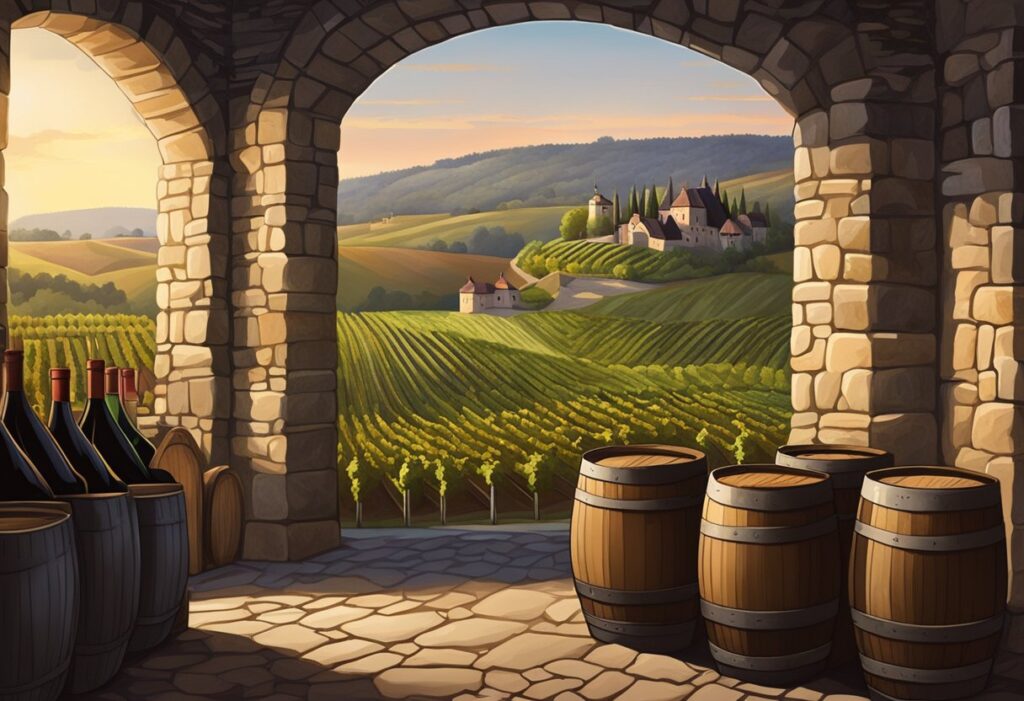
Bordeaux’s ascension to the pinnacle of the wine market was significantly influenced by historical milestones, including the pivotal Golden Age of Bordeaux, which began with the region’s flourishing trade with England in the Middle Ages. The pivotal classification and appellations system initiated in the 19th century further cemented Bordeaux’s reputation, ensuring that wine lovers across the globe would equate the region with excellence.
Despite facing challenges such as phylloxera outbreaks and changing market demands, Bordeaux continues to innovate and adapt, maintaining its revered status in contemporary wine production.
Key Takeaways
- Bordeaux’s wine history reflects its centuries-long significance in France’s culture and wine production.
- The region’s grape varieties and unique terroir have shaped the world-renowned Bordeaux wines.
- Ongoing innovations and adaptation to challenges keep Bordeaux at the fore of the global wine market.
Early Beginnings
Bordeaux’s winemaking history is deeply rooted in ancient traditions, influenced by foreign powers, and shaped by innovative agricultural practices. These diverse influences have helped Bordeaux wines achieve their world-renowned status.
Roman Influence
The Roman occupation initiated the Bordeaux wine legacy that you know today. Early vintage production dates back to around 60 BC, when the Romans recognized the region’s potential for cultivating vineyards thanks to its favorable climate and soil conditions. They were the first to intensively cultivate grapevines in the area, laying the foundation for the sophisticated wine industry you witness here today.
Ascendancy of the English
The marriage in 1152 of Henry Plantagenet and Eleanor of Aquitaine proved pivotal for Bordeaux wines, marking the beginning of English influence. This union made Aquitaine a part of the English kingdom, exponentially increasing the export of Bordeaux wines to England and subsequently across the globe. During The Hundred Years’ War, which lasted until 1453, English demand for these wines remained strong, contributing significantly to the region’s affluence.
Development of Vineyards
After the war, the French crown regained control of Aquitaine, yet the English taste for Bordeaux wines persisted. French winemakers continued to develop their vineyards, importing knowledge about grape growing from various regions and working diligently to improve the quality of their wines. This era saw the evolution of vineyard practices that highlighted regional variances and began to establish the identities of specific wines.
Dutch Contributions
The Dutch played a fundamental role in the 17th century, not only as important traders of Bordeaux wines but also in advancing the region’s winemaking techniques. Their expertise in drainage systems allowed for the reclamation of swampy areas in the Médoc, turning unsuitable land into fertile soil perfect for vineyards.
These sophisticated drainage methods enhanced grape growing conditions and allowed for the expansion of vineyards to areas previously thought unfit for wine production.
By understanding these formative phases, you gain insight into how Bordeaux’s winemaking tradition has become esteemed worldwide. The region’s history is not only an account of its past but also a continuing narrative defining its contemporary character.
Golden Age of Bordeaux
During the Golden Age of Bordeaux, the region experienced unparalleled prosperity, becoming the very heart of wine innovation and trade with a significant cultural fusion that shaped its identity.
Marriage of Cultures
In the 12th century, the marriage between Eleanor of Aquitaine and Henry Plantagenet, who would become the King of England, created a pivotal political alliance between France and England. This union allowed Bordeaux wines, especially claret, to find a welcoming market in Britain. The Gironde Estuary and Garonne River became bustling trade channels, spreading Bordeaux’s fame far beyond France.
Evolving Wine Trade
By the mid-1650s, the wine trade with Britain surged, bolstering Bordeaux’s prosperity. The region’s strategic location along the Garonne facilitated trade, allowing Bordeaux red and white wines to proliferate throughout Britain. Maritime trade expanded due to this Age of Exploration, and the affinity for Bordeaux wines in England contributed greatly to the era’s wealth and the status of Bordeaux wine.
Innovation in Wine Production
The Renaissance was a period of significant innovation in vinification techniques for Bordeaux. The introduction of different grape varieties led to the distinctive blend of red and white Bordeaux wines.
Advancements in winemaking during the Renaissance contributed to the unique character of Bordeaux wines, which included both the robust red wines of Graves and the crisp white wines from other parts of the region. This period laid the foundation for the precise and celebrated winemaking traditions that Bordeaux is known for today.
Classification and Appellations
Bordeaux wine history is deeply intertwined with its classification systems and appellation designations, which underpin the identity and quality standards of its wines.
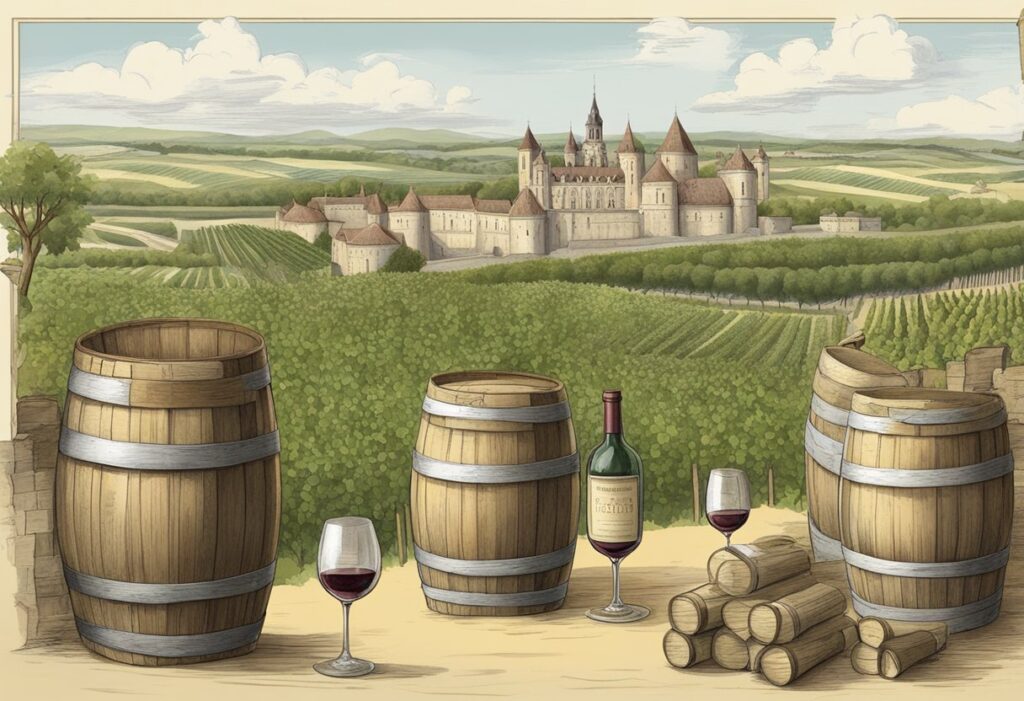
1855 Exposition
The 1855 classification was a pivotal moment for Bordeaux wines, commissioned by Napoleon III for the Paris Exposition Universelle. This historic classification, still in effect today, ranked the wines from the Medoc region and was later extended to include Sauternes and Barsac. Châteaux were categorized into five classes based on reputation and trading price, which at that time, focused on Left Bank wines.
AOC Establishment
In 1936, the AOC (Appellation d’Origine Contrôlée) system was established to legally define the areas where Bordeaux wines could be produced, and set viticulture practices and winemaking standards. This was a significant step in maintaining the quality and ensuring the geographical authenticity of Bordeaux wine. The AOC regulations fundamentally changed the wine landscape, becoming a hallmark for fine wine production throughout France.
Further Classification
Bordeaux didn’t stop with the 1855 classification; additional classifications have been introduced, such as those in St. Emilion in 1955, updated in 1959 and 1973. These classifications took into account other variables like winemaking techniques and quality improvements, ensuring a dynamic and evolving classification system that reflects the continuous strive for excellence in Bordeaux winemaking.
Major Grape Varieties
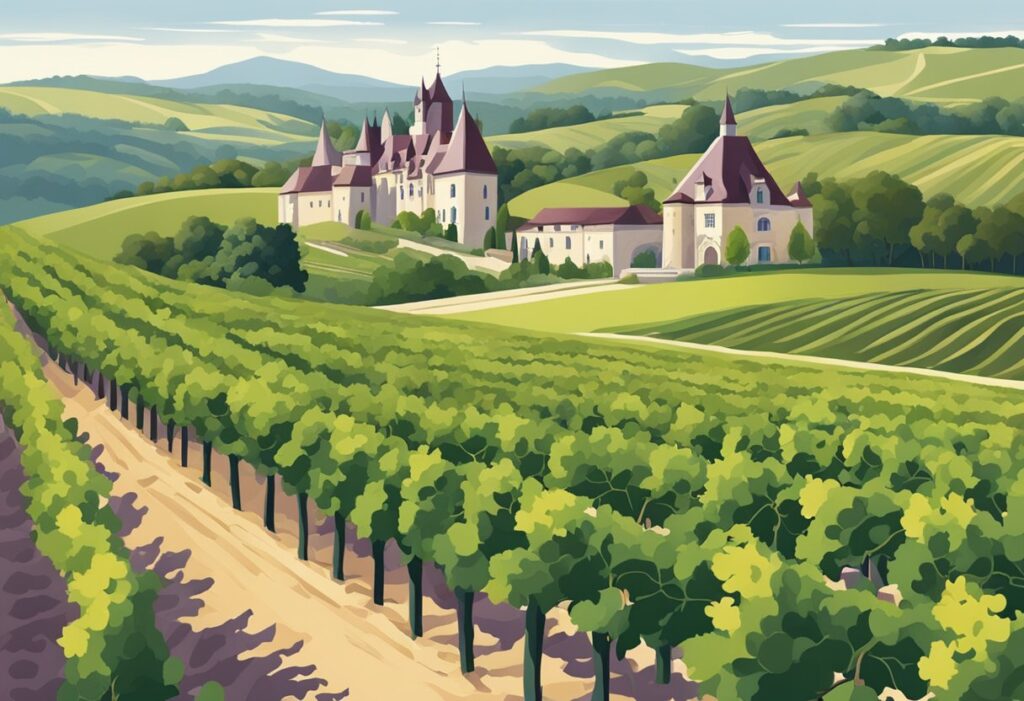
Bordeaux is renowned for its diverse grape selection, with each variety contributing to the region’s storied winemaking legacy. Let’s explore the major grapes that define Bordeaux’s rich palette.
Predominant Reds
Cabernet Sauvignon, Merlot, and Cabernet Franc are the backbone of Bordeaux’s red wines. You’ll discover that Cabernet Sauvignon is favored on the Left Bank of Bordeaux, lending a robust tannin structure and longevity to the wines. It’s often blended to add complexity and depth.
- Merlot: The most widely planted grape in Bordeaux offers wines a softer, plusher texture. It ripens earlier than Cabernet Sauvignon, which makes it paramount in regions where the latter may struggle to ripen fully.
- Cabernet Franc: A bit player yet pivotal for adding finesse, vibrancy, and aromatic lift to blends, Cabernet Franc thrives in cooler parts of the region.
Noteworthy Whites
The white wines of Bordeaux rest mainly on Sauvignon Blanc, Sémillon, and Muscadelle. These grapes are traditionally blended to create wines ranging from dry and crisp to sweet, celebrated Sauternes.
- Sauvignon Blanc: Known for its grassy, zesty characteristics, it brings freshness and acidity to the table.
- Sémillon: Offers body and sweetness, which is why it stars in the region’s luscious dessert wines.
- Muscadelle: Though less common, Muscadelle adds a floral touch to the Bordeaux whites, complementing the other varietals’ profiles.
Geography and Terroir
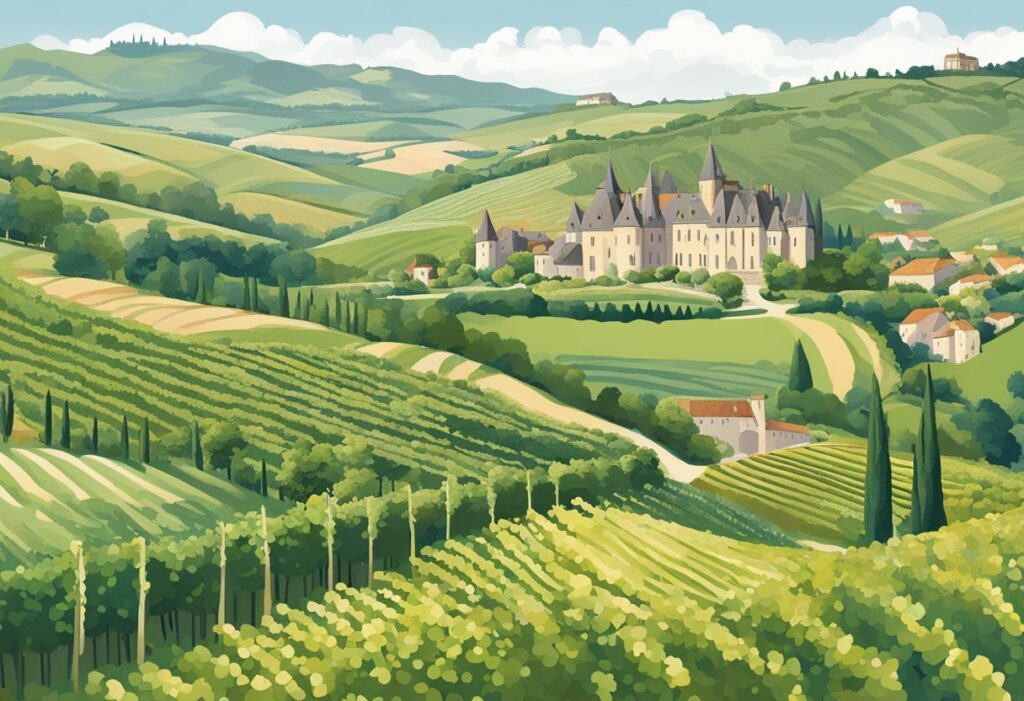
Bordeaux’s identity and prestige in the wine world are rooted in its unique geography and terroir. The region splits mainly into the Left Bank and the Right Bank, each boasting distinctive soil types and microclimates that result in varied and esteemed wines.
Left Bank Versus Right Bank
The Left Bank, known for its deep gravel soils, is home to the renowned Médoc and Graves sub-regions. This gravel-rich terroir, particularly in areas like Margaux and Pauillac, channels heat to the vines and provides excellent drainage, essential for the growth of Cabernet Sauvignon.
The Right Bank, by contrast, features clay and limestone soils which retain moisture and are cooler, favoring the Merlot grape. The St. Emilion and Pomerol areas are esteemed for producing some of the most prestigious Merlot-based wines.
Notable Sub-Regions
Bordeaux is dotted with notable sub-regions, each contributing unique characteristics to its wines. The Médoc on the Left Bank is subdivided into communes such as Margaux, known for wines with finesse, and Pauillac, recognized for powerful and age-worthy wines. On the Right Bank, St. Emilion’s diverse soils give rise to wines both powerful and elegant, while Pomerol, with smaller estates, crafts opulent wines sought after by enthusiasts globally.
Impact of the Rivers
The positioning of vineyards along the Garonne and Dordogne rivers is not by chance. These waterways moderate the climate, protect from frost, and aid in creating the ideal microclimate for vine cultivation. Where these rivers meet, they form the Gironde Estuary, which also plays a critical role in the microclimate and accessibility of the region for trade.
Soil Diversity and Its Effects
In Bordeaux, soil diversity is central to terroir expression. Gravel soils on the Left Bank encourage deep vine rooting and excellent drainage, leading to robust Cabernet Sauvignon wines. On the Right Bank, the higher clay content is conducive to Merlot, resulting in wines with a plusher mouthfeel.
The presence of limestone also contributes to the high quality of wines from areas like St. Emilion, where it helps in producing structured and long-lived wines. Soil diversity extends to vineyards where variations include sand, adding to the complex mosaic that is Bordeaux’s terroir.
Innovations and Challenges
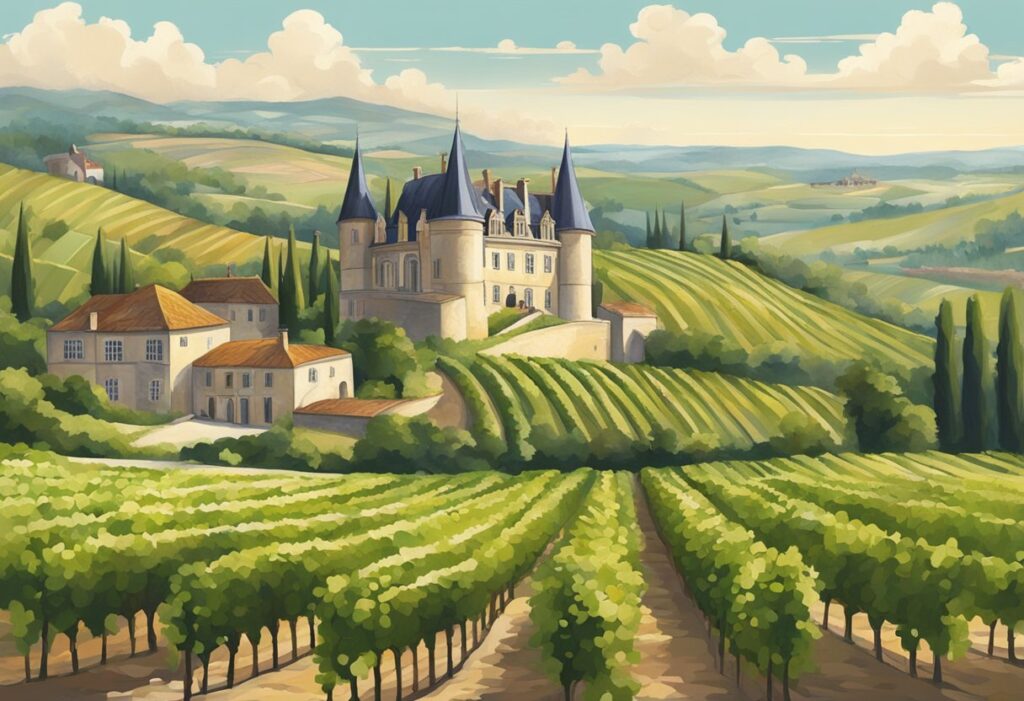
As you explore the history of Bordeaux wine, you’ll find it punctuated by significant challenges and remarkable innovations, particularly in overcoming the devastation of vineyard pests, advancing vineyard practices, and responding to the pressures of climate change.
Phylloxera Devastation
In the late 19th century, your Bordeaux vineyards faced an unprecedented threat from phylloxera. This tiny aphid wreaked havoc, decimating the European wine industry. Historic efforts to save the vineyards led to the grafting of European Vitis vinifera vines onto American rootstock, which was resistant to the pest, thus paving the way for modern viticulture.
Modernization of Vineyard Practices
The 1960s brought about a series of technological advancements in wine production that revolutionized Bordeaux wine practices. Stainless steel tanks introduced steel-tank fermentation, and with the advent of temperature-controlled fermentation systems, your control over the winemaking process became more precise, enhancing the quality of the wine produced.
Combatting Climate Change
In recent years, you’ve witnessed climate change emerging as a new challenge. Bordeaux has been adapting with adaptive strategies including altering grape varietals and adjusting picking times. Bold moves such as these ensure the preservation of the region’s renowned wine reputation in the face of changing climatic conditions, safeguarding your wine production for future generations.
The Bordeaux Wine Market
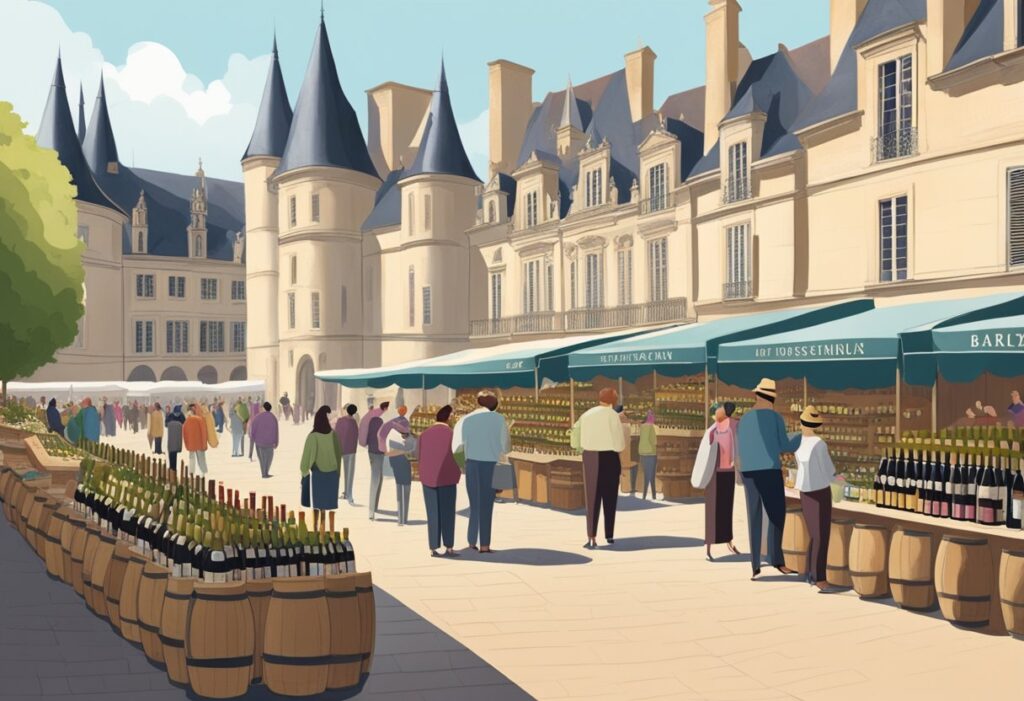
The Bordeaux wine market is a complex system with trade mechanisms that have evolved over centuries, influencing both local economy and the global wine market. Your understanding of its subtleties can significantly enhance your appreciation for Bordeaux wine.
En Primeur System
The En Primeur system allows you to purchase wines early while they are still maturing in the barrel. This unique part of the Bordeaux wine market lets investors and enthusiasts buy wines ahead of their release, often at a lower price point, speculating on their future value. It’s a forward contract sale that greatly impacts wine production and economic factors in the region, turning wine into a more liquid asset before it even reaches the bottle.
Global Exports
Bordeaux wines are a significant presence in the global wine market, with the United States being one of the top importers. These exports not only reflect the diverse wine production of the Bordeaux region but also demonstrate how local winemaking traditions have adapted to meet international tastes and standards. The intricate balance between supply and demand across different markets is a crucial economic factor for Bordeaux winemakers.
Influential Critics and Guides
Wine ratings dramatically sway the valuation and popularity of Bordeaux wines. Critiques from influential figures like Robert Parker have the power to make or break a vintage in the eyes of the world. Moreover, wine guides and critics directly influence buyer preferences, often dictating market trends and pricing structures.
Economic Realities
The economic standpoint of the Bordeaux wine market involves understanding shifts caused by various economic factors. These include production costs, global demand, and even changes in wine labelling practices that could resonate with trends in the USA and other significant markets. Adaptation to these realities is key for the survival and success of Bordeaux wine producers.
Contemporary Bordeaux
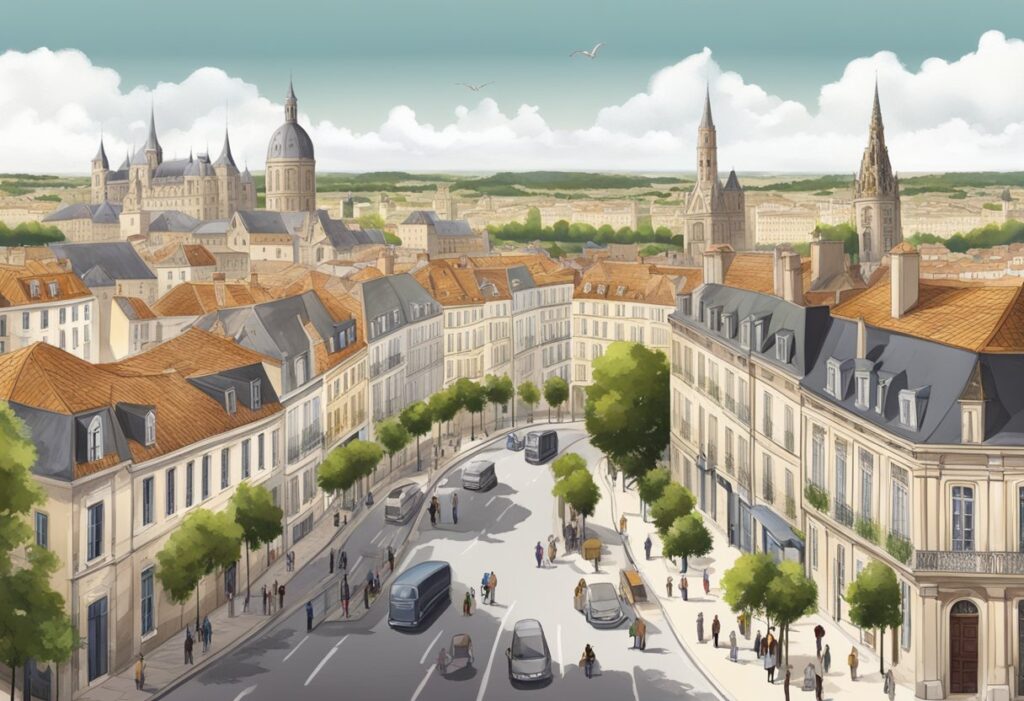
Bordeaux wine history extends far into the past, but its present state is just as vibrant and full of innovation, with a focus on evolving styles and sustainable practices.
Evolution of Wine Styles
Bordeaux wines have seen a shift towards fruitier profiles with a careful balance of tannins and alcohol levels. This change caters to modern palates that favor wines ready to enjoy sooner, while still maintaining the potential for aging.
Rising Stars and New Varietals
The introduction of new grape varieties like Arinarnoa, Castets, and Marselan symbolizes Bordeaux’s dynamic adaptation. These varietals bring diversity to the classic Bordeaux blend and are chosen for their ability to thrive in Bordeaux’s climate, adding unique flavors and sustainable winemaking resilience.
Impact of Wine Tourism
Wine tourism has taken hold in the Bordeaux region, with vinotourism experiences diversifying the interaction between winemakers and enthusiasts. This engagement has boosted the region’s economy and introduced a new audience to the intricacies of Bordeaux winemaking.
Sustainability Efforts
Bordeaux’s journey towards sustainability is marked by an increasing number of vineyards adopting organic practices. The region’s commitment to sustainable winemaking includes efforts that are both environmentally responsible and improve the quality of the vineyard yields. Find out more about biodynamic wine practices.

